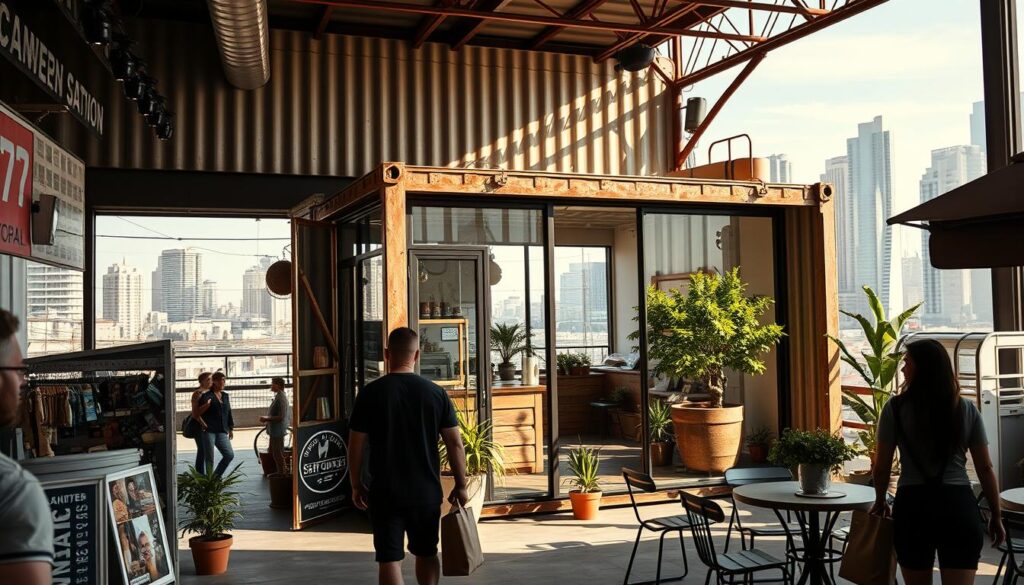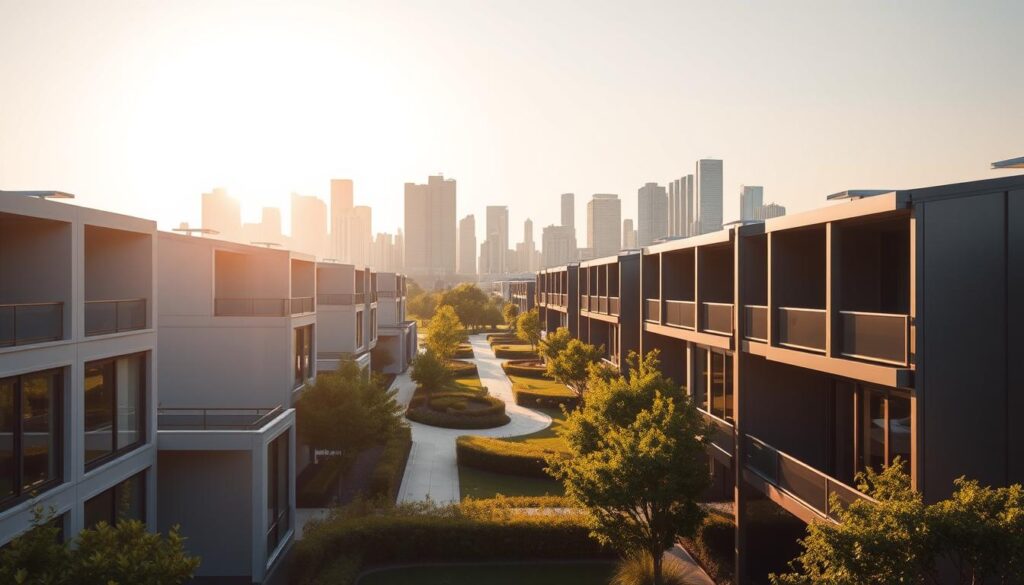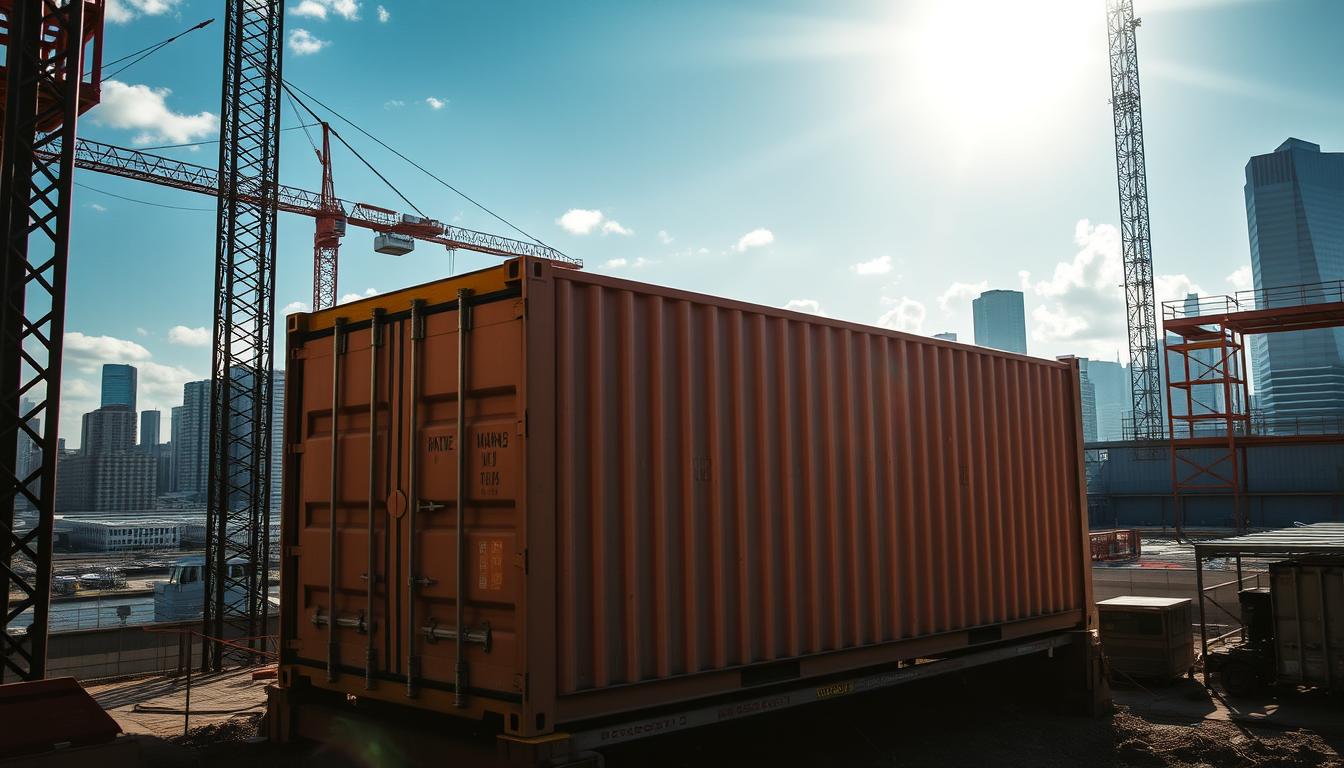Can repurposed shipping containers truly offer a cost-effective solution for creating unique commercial spaces? This question is at the forefront of a growing trend in shipping container construction for businesses looking to make a statement.
As companies continue to seek innovative and budget-friendly options for commercial space design, the use of shipping containers has gained significant traction. With their inherent durability and flexibility, these containers provide an attractive alternative to traditional construction methods.
By choosing used shipping containers, businesses can achieve substantial cost savings, often saving up to 50% or more compared to purchasing new containers. For more insights on the cost benefits, visit K3 Containers to explore the economics behind used shipping containers.
Key Takeaways
- Shipping containers offer a cost-effective solution for commercial spaces.
- Used containers can save businesses up to 50% compared to new containers.
- Shipping container construction provides a unique and durable alternative to traditional building methods.
- Commercial space design using shipping containers is becoming increasingly popular.
- Businesses can benefit from the flexibility and creativity offered by container architecture.
Understanding the Shipping Container Revolution in Commercial Architecture
In recent years, the use of shipping containers in commercial construction has gained significant traction. This trend is transforming the way businesses approach building design and development, offering a unique blend of functionality, sustainability, and cost-effectiveness.
The Rise of Container Architecture in the US Market
The US market has seen a substantial increase in the adoption of container architecture for commercial purposes. This growth is driven by the need for flexible, scalable, and sustainable building solutions. Container architecture allows for rapid deployment and can be easily adapted to various business needs, from retail spaces to office buildings.
“The adaptability of shipping containers has opened up new possibilities for architects and businesses alike, enabling the creation of unique and functional commercial spaces.”
Key Economic Drivers Behind the Trend
Several economic factors are driving the trend towards container architecture. The primary drivers include cost savings, reduced construction time, and the potential for future expansion or relocation. A detailed breakdown of these economic drivers is provided in the following table:
| Economic Driver | Description | Benefit |
|---|---|---|
| Cost Savings | Reduced material and labor costs | Lower initial investment |
| Reduced Construction Time | Faster construction and deployment | Quicker occupancy and revenue generation |
| Flexibility and Scalability | Ease of expansion or relocation | Adaptability to changing business needs |
Types of Commercial Applications Gaining Popularity
Container architecture is being applied across various commercial sectors, including retail, office spaces, and food and beverage venues. The versatility of shipping containers allows for innovative and customized solutions that meet the specific needs of different businesses.
- Retail spaces: Unique and attractive storefronts
- Office buildings: Flexible and modern workspaces
- Food and beverage venues: Trendy and functional establishments
The rise of container architecture represents a significant shift in commercial construction, offering businesses a cost-effective, efficient, and sustainable alternative to traditional building methods.
Cost Breakdown: Initial Investment for Container Commercial Spaces
To embark on a cost-effective modular building project, it’s essential to dissect the initial investment required. The economics of shipping container construction hinges on understanding the upfront expenses, which include container acquisition, site preparation, and installation costs.
Container Acquisition Costs and Quality Considerations
The first major cost is acquiring the shipping containers. The price varies based on size, condition, and location. New containers are more expensive but offer better durability and fewer maintenance issues. Used containers, while cheaper, may require additional investment for refurbishment.
Site Preparation and Foundation Requirements
Before installation, the site must be prepared, which includes clearing the land, grading, and laying the foundation. The type of foundation required can significantly impact costs, with options ranging from simple gravel bases to more complex concrete foundations.
Delivery, Crane Rental, and Installation Expenses
Delivery and installation costs are also significant. These include transporting the containers to the site and using cranes for placement. The complexity of the installation and the crane rental duration can affect these costs.
Hidden Costs to Anticipate
Hidden costs can arise from unexpected site conditions, changes in local regulations, or delays in delivery. It’s crucial to budget for contingencies to avoid cost overruns. Understanding these potential expenses helps in planning a more accurate initial investment.
By breaking down these costs, businesses can better understand the financial commitment required for shipping container commercial spaces, making it easier to plan and execute such projects.
Modification and Customization Expenses
Modification and customization are crucial steps in converting shipping containers into functional commercial areas. These processes can significantly impact the overall cost but are essential for creating spaces that meet specific business needs.
Structural Modifications and Engineering Costs
Structural modifications often involve cutting doors and windows, reinforcing the structure, and ensuring the container can support any additional flooring or roofing. Engineering costs can vary widely depending on the complexity of the modifications and the need for specialized labor.
Insulation, Ventilation, and Climate Control Solutions
To make a shipping container habitable, insulation, ventilation, and climate control are critical. The cost of these modifications depends on the materials chosen and the size of the container. Proper insulation can reduce energy costs in the long run.
Interior Finishing and Design Expenses
Interior finishing includes installing flooring, walls, ceilings, and lighting. Design expenses can vary based on the materials selected and the complexity of the design. Custom designs can increase costs but may be necessary for branding purposes.
Cost-Saving Modification Strategies
To save on modification costs, consider the following strategies:
- Opt for standard modifications that don’t require extensive engineering.
- Choose cost-effective materials for insulation and interior finishing.
- Repurpose existing elements of the container where possible.
| Modification Type | Average Cost | Factors Affecting Cost |
|---|---|---|
| Structural Modifications | $5,000 – $15,000 | Complexity, labor costs |
| Insulation & Climate Control | $3,000 – $8,000 | Materials, container size |
| Interior Finishing | $8,000 – $20,000 | Materials, design complexity |
The Economics of Using Shipping Containers for Commercial Spaces
As the commercial real estate market evolves, shipping containers are emerging as a viable alternative to traditional construction methods. This shift is largely driven by the economic benefits associated with shipping container construction, including reduced material costs and faster project completion times.
Detailed Cost Comparison: Containers vs. Traditional Construction
A key factor in the growing popularity of shipping containers for commercial spaces is their cost-effectiveness compared to traditional building methods. The initial investment for container structures is often significantly lower, primarily due to the reuse of existing containers.
| Cost Component | Container Construction | Traditional Construction |
|---|---|---|
| Initial Investment | $50-$100 per sq. ft. | $100-$200 per sq. ft. |
| Construction Time | 3-6 months | 6-12 months |
| Maintenance Costs (5-year avg.) | $5-$10 per sq. ft. | $10-$20 per sq. ft. |
Space Efficiency and Revenue Per Square Foot
Shipping containers also offer the advantage of space efficiency. Their modular design allows for easy expansion or reconfiguration, maximizing the use of available space. This efficiency can lead to higher revenue per square foot, as businesses can optimize their layouts for better customer engagement and operational efficiency.

Long-term Maintenance Economic Impact
The long-term maintenance costs for container structures are generally lower than those for traditional buildings. The use of sustainable building materials and robust construction methods contributes to this advantage. Additionally, the modular nature of container construction facilitates easier repairs and upgrades.
Depreciation Considerations for Container Structures
When evaluating the economics of shipping container commercial spaces, it’s crucial to consider depreciation. Container structures can depreciate more rapidly than traditional buildings, depending on their initial condition and modification extent. However, their initial cost savings can offset this factor, making them an attractive option for businesses looking for affordable, flexible commercial spaces.
Regulatory Considerations and Their Financial Impact
Regulatory challenges pose significant financial implications for innovative commercial building solutions like container architecture. Understanding these regulatory considerations is crucial for project planning and budgeting.
Building Codes and Compliance Costs in Different US Regions
Building codes vary significantly across different regions in the US, affecting compliance costs for container commercial spaces. For instance, seismic retrofitting requirements in earthquake-prone areas can add substantial costs.
“The complexity of navigating building codes can be a significant barrier to entry for container architecture projects,” notes a leading industry expert.
Zoning Challenges and Permitting Expenses
Zoning laws and permitting expenses are other critical regulatory considerations. Zoning restrictions can limit where container commercial spaces can be located, while permitting processes can be time-consuming and costly.
Insurance Considerations and Risk Management
Insurance requirements for container architecture projects can be unique due to their unconventional nature. Proper risk management strategies are essential to mitigate potential risks and ensure adequate coverage.
By understanding and addressing these regulatory challenges, developers can better navigate the complexities of container commercial spaces and ensure the financial viability of their projects.
Time-to-Market Advantage: Economic Benefits of Rapid Deployment
The rapid deployment of shipping containers for commercial spaces offers significant economic benefits, primarily through a quicker time-to-market. This advantage allows businesses to start operations sooner, generating revenue earlier than traditional construction methods would permit.
Construction Timeline Comparison with Traditional Methods
Container structures can be deployed much faster than traditional buildings. While conventional construction projects can take years to complete, container conversions can be ready in a matter of months. This accelerated timeline is due to the prefabricated nature of shipping containers, which are largely constructed in a factory before being transported to the site.
- Faster Construction: Container structures are built in a controlled environment, reducing weather-related delays.
- Efficient Assembly: Containers arrive on-site ready for assembly, minimizing on-site labor.
Revenue Generation Opportunities from Faster Completion
By getting to market faster, businesses can start generating revenue sooner. This early entry into the market can be crucial for capturing market share and establishing brand presence before competitors.
- Early revenue generation
- Competitive market advantage
- Potential for faster return on investment
Reduced Labor Costs Through Efficient Assembly
The assembly of container structures is typically more efficient than traditional construction, leading to reduced labor costs. This efficiency is a result of the modular design and the fact that much of the construction is completed off-site.
Calculating the Value of Time Savings
To calculate the value of time savings, businesses should consider the difference in construction time between container structures and traditional buildings, multiplied by the daily operational costs or potential revenue. This calculation can help quantify the economic benefits of choosing a container structure over traditional construction methods.

Case Studies: Successful Container Commercial Projects and Their Economics
Repurposed container structures are gaining traction in the commercial real estate market, offering innovative and cost-effective solutions. This trend is driven by the economic benefits and flexibility that containers provide. Several successful container commercial projects demonstrate the viability of this construction method.
Retail Container Developments and Their ROI
Retail container developments have shown significant returns on investment (ROI). For instance, a container shopping mall in Portland, Oregon, reported a 20% increase in foot traffic within the first six months of operation. The project utilized 50 repurposed containers, creating a unique shopping experience that attracted a large customer base.
Office Space Container Conversions: Cost Analysis
Converting containers into office spaces has proven to be cost-effective. A tech startup in San Francisco converted 10 containers into a modern office complex, reducing construction costs by 30% compared to traditional methods. The project also achieved a 25% reduction in energy costs due to efficient insulation and climate control systems.
Food and Beverage Container Venues: Economic Performance
Container venues for food and beverage businesses have become increasingly popular. A coffee shop made from repurposed containers in Seattle saw a 40% increase in sales after opening, attributed to its unique design and eco-friendly appeal. The initial investment was recouped within the first year of operation.
Lessons Learned from Failed Container Projects
While many container projects succeed, some fail due to regulatory challenges or poor design. A key lesson is the importance of thorough planning and compliance with local building codes. Additionally, integrating sustainable design elements can enhance the economic performance of container projects.
Sustainability Economics: Long-term Benefits of Container Construction
Container construction offers a unique blend of sustainability and economic viability for commercial spaces. As businesses increasingly prioritize environmental responsibility, the long-term benefits of using shipping containers for commercial projects are gaining attention.
Energy Efficiency and Utility Cost Savings
One of the significant advantages of container construction is its potential for energy efficiency. Containers can be modified with sustainable building materials and designed to optimize insulation, reducing the need for heating and cooling. This results in lower utility costs over time, contributing to the overall economic viability of the project.
Environmental Impact and Green Building Incentives
The environmental benefits of repurposing shipping containers for commercial use are substantial. By reusing existing structures, we reduce the demand for new materials and minimize waste. Many regions offer green building incentives for projects that incorporate sustainable practices, providing additional financial benefits.
Marketing Value of Sustainable Commercial Spaces
Sustainable commercial spaces have a significant marketing advantage. Businesses operating in environmentally friendly buildings can enhance their brand image and appeal to eco-conscious customers. This marketing value can translate into increased customer loyalty and revenue.
Quantifying the ROI of Sustainability Features
To fully understand the economic benefits of container construction, it’s essential to quantify the return on investment (ROI) of sustainability features. This involves analyzing energy savings, potential incentives, and the marketing value of being a sustainable business. By doing so, businesses can make informed decisions about investing in innovative commercial building solutions.
Financing Options and Investment Strategies for Container Projects
The rise of cost-effective modular buildings has led to an increase in financing options for container projects. As investors and developers become more interested in shipping container construction, understanding the financial landscape is crucial.
Traditional and Alternative Funding Sources
Financing for container projects can be secured through both traditional and alternative sources. Traditional funding includes bank loans and mortgages, while alternative sources encompass private investors, crowdfunding, and specialized modular building financing programs.
ROI Projections and Investor Considerations
When evaluating container projects, investors focus on Return on Investment (ROI) projections. A thorough analysis of potential revenue streams, operational costs, and market demand is essential for creating compelling ROI projections.
| Financing Option | Typical ROI | Risk Level |
|---|---|---|
| Traditional Bank Loan | 8-12% | Moderate |
| Private Investors | 10-15% | High |
| Crowdfunding | 6-10% | Variable |
Tax Incentives and Depreciation Benefits
Container projects can benefit from various tax incentives, such as depreciation benefits and potential green building tax credits. Understanding these incentives is crucial for maximizing investment returns.
Creating Compelling Financial Proposals for Lenders
To secure financing, developers must create comprehensive financial proposals that include detailed project plans, financial projections, and risk assessments. Highlighting the unique benefits of shipping container construction, such as reduced construction time and environmental sustainability, can make proposals more attractive to lenders.
Scalability and Expansion: Economic Advantages of Modular Design
The modular design of repurposed container structures offers unparalleled flexibility in scalability and expansion. This adaptability is a significant economic advantage in the rapidly changing business landscape.
Phased Development Strategies and Cash Flow Management
One of the key benefits of modular container design is the ability to implement phased development strategies. This approach allows businesses to expand their operations in stages, managing cash flow more effectively and reducing the financial strain of large-scale developments.
By adopting a phased approach, companies can align their expansion with market demand, ensuring that growth is both sustainable and economically viable.
Relocation Possibilities and Their Economic Impact
Container structures offer the unique advantage of being easily relocatable. This feature is particularly beneficial for businesses operating in volatile markets or those with uncertain long-term prospects.
“The ability to relocate our operations has been a game-changer for our business, allowing us to adapt to changing market conditions without being tied to a specific location.”
The economic impact of relocation possibilities should not be underestimated, as it can significantly reduce the financial risks associated with long-term property commitments.
Adaptation to Changing Market Demands
The modular nature of container architecture enables businesses to quickly respond to changing market demands. Whether it’s expanding to meet growing customer needs or reconfiguring spaces for new product lines, container structures can be adapted rapidly and cost-effectively.
Cost Analysis of Expansion vs. New Construction
When considering expansion, businesses often face the decision between modifying existing container structures or constructing new facilities. A detailed cost analysis reveals that expanding container structures is typically more cost-effective than new construction.
- Lower upfront costs
- Reduced construction time
- Minimal disruption to ongoing operations
Conclusion: Evaluating the Economic Viability of Container Commercial Spaces
The Economics of Using Shipping Containers for Commercial Spaces reveals a promising trend in innovative commercial building solutions. By repurposing shipping containers, businesses can create unique, functional spaces that are both cost-effective and sustainable.
Key findings indicate that container commercial spaces offer significant economic benefits, including reduced construction costs, faster deployment, and lower maintenance expenses. Their modular design allows for scalability and flexibility, making them an attractive option for businesses looking to adapt to changing market demands.
The use of shipping containers for commercial purposes not only reduces waste but also provides an opportunity for creative expression. As the demand for sustainable and innovative commercial building solutions continues to grow, the economic viability of container commercial spaces is likely to improve.
By embracing this trend, businesses and investors can capitalize on the benefits of container architecture, driving growth and profitability in the process.

